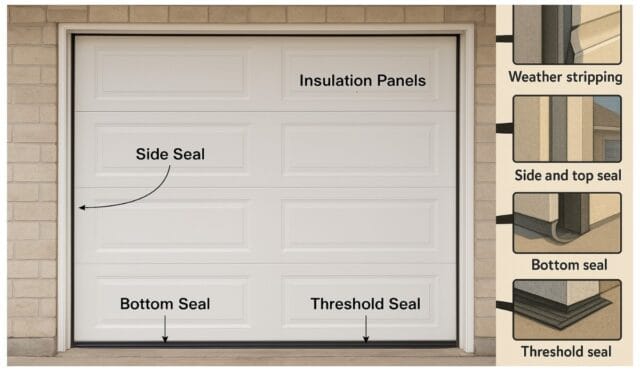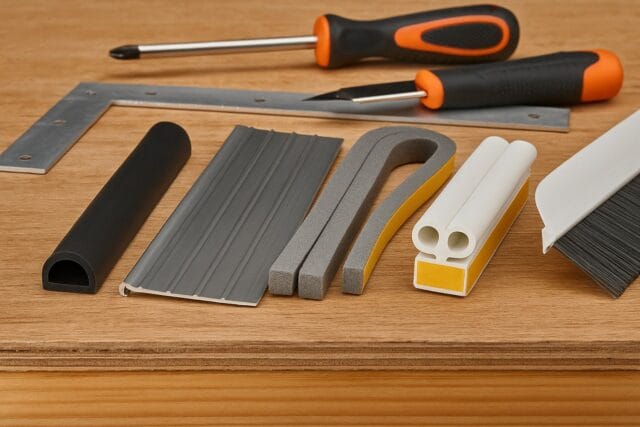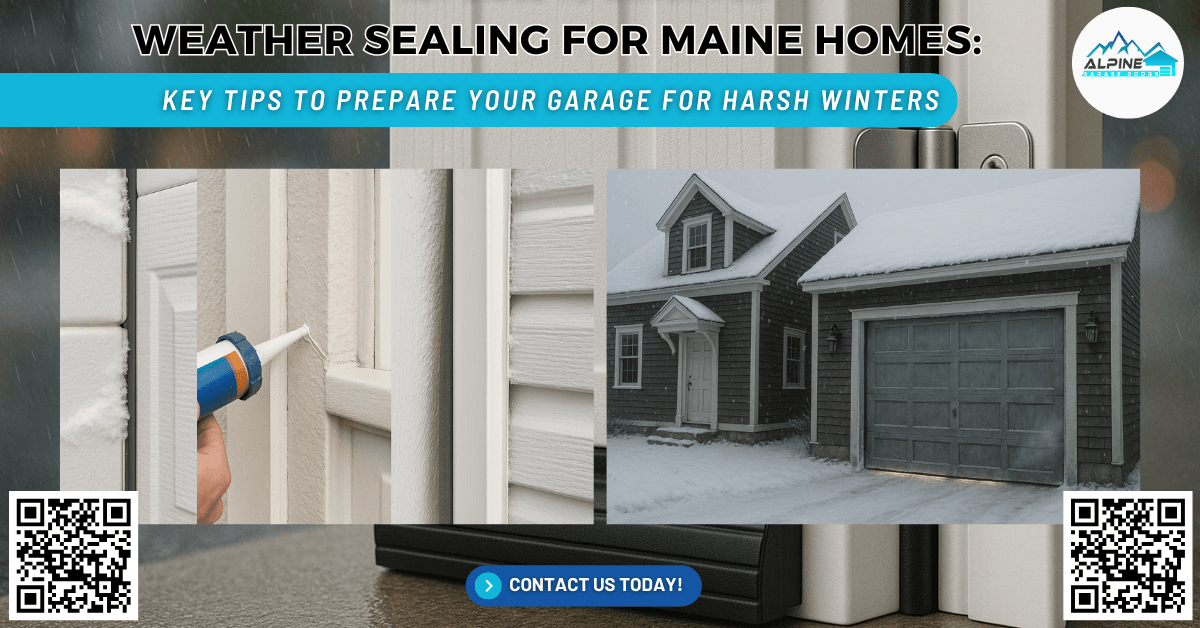A Real-World Example
Last winter, one of our customers in Portland, Maine, called us in distress after finding a thick layer of frost coating everything inside their garage, from holiday decorations to their snowblower. Although the garage door appeared fine from the outside, cold air was sneaking in through small gaps along the bottom seal, side seal, and door trim seal. The concrete floor felt like an ice sheet, and the garage was almost as cold as the outdoors. We quickly assessed the situation and found that their garage door seal system had deteriorated. The bottom seal was brittle, the threshold seal was warped, and the side seal had small tears. We replaced all seals with high-quality EPDM rubber components, installed a new aluminum threshold with a vinyl sweep, added insulation adhesive panels to the interior door surface, and performed a full seal inspection. When the next snowstorm arrived, their garage stayed warm, dry, and free of frost.
Why This Matters for Maine Homes
In Maine, where winter temperatures regularly dip below zero, harsh nor’easters bring heavy snow, and high winds create wind chills that feel even colder, a poorly sealed garage can cause more problems than you might think. Cold drafts lead to higher heating bills. Melted snow that seeps inside can cause mold, rust, and condensation damage. Even stored belongings can warp or crack when exposed to freezing conditions. Effective weatherproofing using garage door seals, door sweeps, and insulation upgrades is one of the most affordable and effective ways to protect your home from these conditions.
A Surprising Statistic
According to the U.S. Department of Energy (DOE), homes can lose up to 30 percent of their heating energy through gaps and leaks around doors and windows. In a Maine winter, where heating systems often run for months on end, that lost heat represents not only higher utility bills but also unnecessary strain on your furnace or boiler. By installing proper bottom seals, threshold seals, and perimeter door weather stripping, you can significantly reduce air leaks, improve energy efficiency, and extend the lifespan of your garage door system.
Understanding Weather Sealing for Maine Garages
Weather sealing is the process of closing every gap around your garage door to prevent the intrusion of drafts, moisture, pests, and debris. This process involves more than simply adding a rubber strip under the door. Proper weather sealing is a combination of several components that work together to keep your garage airtight and energy efficient.

Key Components of Garage Door Weather Sealing
- Bottom Seal or Garage Door Bottom Seal
This is a flexible strip, often made of EPDM rubber, vinyl sweep, or adhesive rubber seal, attached to the bottom of the garage door. It prevents cold air, water, and pests from entering. For Maine homes, a high-quality EPDM rubber bottom seal is ideal because it remains flexible in extreme cold. - Threshold Seal
Installed directly on the garage floor, usually made from aluminum threshold bases with rubber or vinyl inserts. The threshold works in combination with the bottom seal to create a double barrier against water and snow. - Perimeter Weather Stripping or Side Seal and Top Seal
Door weather stripping along the vertical sides and top of the garage door frame prevents wind-driven snow and rain from entering. A magnetic door strip can be used on certain insulated metal doors for an even tighter fit. - Insulation and Interior Seals
Garage insulation can be achieved using foam seal panels, window insulation kits, or even thermal curtains to maintain a stable temperature. Adding window caulking or a window insulation film on garage windows prevents heat loss. - Specialized Seals and Accessories
Foam weatherstrip tape, adhesive door seal strips, and door sweep kits for any service doors or pedestrian entry doors in the garage complete the weatherproofing package.
Why Maine Winters Are a Special Challenge
Maine’s winter climate is not just cold, it is relentless. Understanding why this environment is so tough on weather seals will help you choose the right materials and installation techniques.
Extreme Cold and Heavy Snow
Temperatures often remain below freezing for extended periods, causing standard rubber door strips or foam seals to stiffen, crack, or lose flexibility. EPDM rubber and silicone sealant are preferred for Maine because they maintain elasticity in cold temperatures.
Freeze-Thaw Cycles
During daylight hours, snow and ice near your garage may melt slightly, only to refreeze overnight. This expansion and contraction can push seals out of alignment, warp aluminum thresholds, and deteriorate adhesive door seals.
High Winds from Nor’easters
Winter storms often bring winds exceeding 40 miles per hour. These winds can push snow and rain sideways into any small gap along the side seal, under door seal, or door sweep, overwhelming seals that are not properly installed or maintained.
Signs Your Garage Needs New Weather Sealing
- Cold air drafts felt near the garage door or service door.
- Water puddles or damp spots after snow or rain.
- Visible light shines through the sides or bottom of the garage door when closed.
- Higher than normal winter heating bills despite no change in thermostat settings.
- Presence of pests such as mice or insects in the garage.
- Cracked seal material, loose door sweeps, or obvious seal deterioration.
Step-by-Step Guide to Weather Sealing Your Garage for Winter
1. Conduct a Thorough Seal Inspection
Use a flashlight and look for daylight shining through the garage door edges. Check the bottom seal for cracks, flattening, or missing sections. Inspect the side seals and top seal for gaps or loose fittings. Examine the aluminum threshold and threshold seal for wear or peeling.
2. Select the Right Materials for Maine’s Climate
- EPDM Rubber: Best for extreme cold flexibility.
- Vinyl Sweep: Affordable but may stiffen below zero.
- Silicone Sealant: Remains flexible in low temperatures and works well for caulking edges.
- Foam Tape: Good for irregular surfaces and gaps.

3. Measure Accurately
Use a measuring tape to measure the width and height of the door opening. Accurate measurements ensure that seals like the door sweep or garage door bottom seal fit snugly without leaving gaps.
4. Replace the Garage Door Bottom Seal
Remove the old seal with a utility knife if necessary. Clean the retainer track and slide in a new EPDM rubber or adhesive rubber seal. Use installation adhesive if the track is worn.
5. Install Perimeter Weather Stripping
Cut the door trim seal or side seal with miter shears to ensure clean edges. Attach with screws or nails into the frame, making sure the rubber strip presses lightly against the door surface for a complete seal.
6. Add a Threshold Seal to the Floor
Clean the floor with a degreaser before applying. Mark the placement with chalk, apply installation adhesive using a sealant gun or caulking gun, and firmly press the threshold in place.
7. Insulate Windows and Panels
Apply window insulation film or a heat-shrink seal to any garage windows. Use foam seal panels or reflective insulation kits on the door itself to improve thermal performance.
Maintenance Tips to Extend the Life of Your Weather Sealing
- Seasonal Replacement
Always replace worn or cracked seals before the start of winter to ensure maximum protection. In Maine, where freezing temperatures and heavy snowfall are common, most homeowners find that seasonal replacement every two to three years is necessary due to the accelerated wear caused by ice, road salt, and temperature fluctuations. - Regular Cleaning
Dirt, sand, and road salt can accumulate on rubber door strips, foam seals, and vinyl sweeps, reducing their flexibility and causing deterioration over time. Clean them every couple of months using mild soap, warm water, and a soft cloth or sponge. Avoid harsh cleaners that can dry out rubber and make it brittle. - Lubrication
Applying a silicone-based spray lubricant to your garage door seals at least twice during the winter helps maintain their pliability, even in sub-zero weather. This also prevents sticking and tearing when the seals freeze to the garage floor after snow or ice. - Check After Storms
Heavy snow or ice storms can shift seals, loosen the under-door seal, or even cause threshold seals to peel away from the floor. After each significant weather event, do a quick visual inspection and feel along the edges for any cold air leaks. Addressing small issues immediately can prevent bigger, more expensive repairs later in the season.
Benefits of Proper Weather Sealing
Improved Energy Efficiency
A well-sealed garage significantly reduces heat loss by preventing cold drafts from entering and warm air from escaping. This directly lowers heating costs and helps your home meet Energy Star (EPA) guidelines for energy efficiency. Over time, improved insulation and draft protection can reduce strain on your heating system, extending its lifespan and saving you money on repairs.
Protection Against Moisture Damage
Properly installed garage door seals, threshold seals, and side seals keep melting snow, rain, and ice from seeping into your garage. By keeping moisture out, you reduce the risk of mold growth, condensation damage, and wood rot on framing or stored items. This moisture control also helps prevent rust on tools, vehicles, and other metal surfaces.
Pest Prevention
Even small gaps under a garage door or along the door trim seal can be an open invitation to rodents, insects, and other pests. Quality weatherproofing acts as a physical barrier, using tight-fitting rubber door strips and door sweeps to block entry points and protect your stored belongings from contamination or damage.
Increased Comfort and Usability
A warmer, drier garage is far more functional, especially during the cold Maine winter. Whether you are storing valuables, working on home projects, or using the space for hobbies, effective weather sealing ensures the environment is comfortable and free from drafts. This added comfort can even make your garage a more versatile space year-round.
Choosing a Professional for Weather Sealing in Maine
Hiring a professional ensures that your weatherproofing meets standards set by the International Code Council and ASHRAE for energy efficiency and building integrity. Professional installers use high-quality tools like miter shears, sealant guns, heat guns, and installation adhesive for precise, long-lasting results. They can also identify hidden air leaks and recommend products tested by Underwriters Laboratories (UL) for durability and performance.
Common Mistakes to Avoid
Using indoor-only seals that cannot withstand freezing temperatures
Many homeowners mistakenly choose seals designed for interior use, such as lightweight foam or thin vinyl strips, which can quickly crack or lose flexibility in Maine’s extreme winter cold. Always select outdoor-grade materials like EPDM rubber or heavy-duty vinyl sweeps rated for sub-zero conditions to ensure longevity.
Taking incorrect measurements that leave gaps in the seal
Even a small measurement error can leave gaps along the sides or bottom of the garage door, allowing cold air and moisture to seep inside. Use a precise measuring tape and measure twice before cutting. A poor fit can undermine even the highest-quality seal materials.
Neglecting to weatherproof side doors or service doors
Many garages have side or back entry doors that are often overlooked. Without proper door sweep kits, foam weatherstrip tape, or adhesive door seals, these doors can allow just as much cold air and moisture in as an unsealed garage door. Every entry point should be addressed.
Failing to clean the installation surface before applying adhesive seals or thresholds
Dust, oil, and debris on the installation surface can prevent adhesives from bonding properly. Before applying an adhesive door seal, aluminum threshold, or foam tape, thoroughly clean the surface with a mild cleaner and allow it to dry completely to ensure a strong, lasting hold.
Local Considerations for Maine Homeowners
Homes along Maine’s coastline are constantly exposed to salty air and higher humidity levels, which can cause rapid corrosion of standard metal components. In these areas, it is recommended to use corrosion-resistant hardware such as stainless steel or PVC retainers for the side seal and top seal to ensure long-term durability. Coastal homeowners should also schedule more frequent seal inspections since salt buildup can deteriorate rubber and vinyl materials faster than in inland areas.
For rural properties, wildlife and rodents can be a major concern. Installing rodent-proof bottom seals made with reinforced materials or embedded metal mesh can help block chewing and gnawing attempts from pests seeking warmth inside the garage during winter. These seals, combined with foam weatherstrip tape around smaller entry points, offer an added layer of protection.
Historic homes with custom wood garage doors often require a more specialized approach to weatherproofing. Using precision cutting tools, vinyl trim, and custom-fit door trim seals ensures the integrity and charm of the original door design while significantly improving weather sealing performance. In some cases, installation adhesive or a silicone sealant may be preferred over visible fasteners to preserve the aesthetic value.
Frequently Asked Questions (FAQs)
- How often should I check my garage door seals during the winter in Maine?
It is best to inspect your garage door seals at least once a month during the winter, as extreme temperatures and ice buildup can cause rapid wear and tear. - Can I install weather sealing on an older wooden garage door?
Yes, weather sealing can be installed on wooden garage doors, but you may need specialized trim seals or custom fitting to ensure proper contact and protection. - Is weather sealing effective for detached garages?
Detached garages benefit from weather sealing just as much, helping protect stored tools, vehicles, and belongings from moisture, pests, and freezing temperatures. - Will weather sealing help reduce noise from outside?
Yes, high-quality weather seals can also help reduce outside noise, making the garage quieter and more comfortable to work in.
How Can Alpine Garage Doors New England Help You
At Alpine Garage Doors New England, we specialize in preparing garages for the toughest Maine winters. Our team uses premium EPDM rubber garage door seals, heavy-duty aluminum thresholds, and professional-grade foam seals for maximum performance. We conduct full inspections, recommend products that meet or exceed Energy Star and DOE efficiency standards, and ensure your installation is secure and durable. We also offer garage insulation solutions, window insulation kits, and comprehensive air leak repair to make your garage comfortable all year.
We can custom-fit your weather sealing to your specific garage door size and type, whether it is a modern insulated steel model or a classic wooden door. Our technicians are trained in best practices for mold prevention, condensation control, and long-term energy efficiency.
Call us today to schedule your weather sealing service before winter arrives.
📍 Address: 150 Cross St, Boston, MA 02109
📞 Phone: (617) 865 7222
Final Thoughts
Winter in Maine can be beautiful, but it can also be unforgiving. Your garage is a critical barrier between your home and the elements. Proper weather sealing, using the right bottom seals, side seals, threshold seals, foam weatherstrip tape, and insulation materials, is one of the smartest investments you can make. Not only will it protect your belongings and prevent costly damage, it will also save you money on heating costs, improve your comfort, and extend the life of your garage door system.
Whether you choose to handle the project yourself with tools like a measuring tape, utility knife, and caulking gun, or prefer to hire a professional with advanced expertise, the key is to act before the first snowstorm arrives. Preparing now ensures a warm, dry, and secure garage all winter long.

